Creative License
Renowned cartoonist and writer Lynda Barry, now on the UW’s faculty, teaches her students that using their hands engages their brains — and leads to the creativity within.
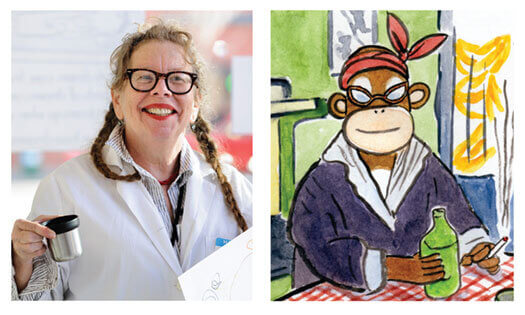
An award-winning cartoonist and author, Lynda Barry, left (and as depicted by Barry herself at right), is now an associate professor of interdisciplinary creativity — a position that allows her to share a long-held belief: that art and science need not exist apart, that disciplines can intersect and enrich each other.
I am sitting on a stool in front of a long wooden table in a ’60s-style bunker-turned-art-studio on the sixth floor of the Mosse Humanities Building that might as well be underground. There’s an unused composition notebook in front of me, along with blank notecards, pens, and two baskets overflowing with candy. It’s my first time sitting in on this writing class, and I haven’t a clue what to expect.
Twelve graduate students surround the table — some smoothing fingertips across their prized notebooks, others in light conversation. Some, like me, are unwrapping and inhaling Butterfinger bars and Laffy Taffy at a most impressive rate.
Glancing at our empty candy wrappers, a fifty-something woman dressed in black, with thick-rimmed glasses and flowing ginger braids compressed with a red bandana, approaches the head of the table. “It’s the candy that lures you in,” she says in her best evil scientist voice, hands folded together in conniving delight. “Every time.” A reassuring smile widens behind red lipstick. Her maniacal laugh transforms into a real one, an uncontrolled moment of hilarity, and we catch ourselves joining in.
Indeed, our professor, Lynda Barry, award-winning cartoonist and author, does have an agenda: she wants to convince us that we can write, draw, think, and create in a way that we’ve never done before; she wants to bring the mundane to life through storytelling; and she wants to give us a framework to deepen our understanding of ourselves and our work across disciplines.
“Write what you see,” Barry says. It’s the name of the class I attended every Monday last fall. The course is one of two she offered during her first semester as associate professor of interdisciplinary creativity at the Art Department and the Wisconsin Institute for Discovery (WID), the transdisciplinary research institute where I work.
Barry considers herself a “delivery woman,” packaging her forty-plus years of visual arts experience for students in much the same way that instructors did for her. Some describe her unconventional classes as mashups of stand-up comedy and boot camp. She controls every second of the two hours we’re gathered around the table, with timed sessions to carve out memories and narratives from our personal and professional lives. It’s a carefully planned act.
“It’s unabashed, uninhibited. I think Lynda’s asking us to reconnect with that side of ourselves,” says Alon Andrews MSx’15, an education graduate student who was also enrolled in the class. “I imagine she’s suggesting that, as we get a little older, we experience our environment in kind of a diluted way compared to what kids do.”
After arriving at the university, Barry noticed a sentiment, especially among graduate students during their first year, of feeling lost as they entered the whirlwind of academia. The word transformative comes up when I talk to students about Barry’s classes — a word she also uses to describe her own experience teaching.
“I really hope that it does for the students what it’s done for me — the feeling that life is worth living,” she says. “This feeling of loneliness can illuminate the world or close it off. It’s for any of us who’ve had a big event in our lives, like maybe somebody died or experienced trauma. You’re pushed to see the aliveness in the world.”
The first class was definitely alive. In two hours’ time, I had relived and written about memories archived deeply in my mind. I smelled the burning leaves from the time I used a rope swing to cross a back yard fire when my dad wasn’t looking. I felt the blood rushing to my cheeks when I talked about the time I accidentally flushed my babysitter’s ring down the toilet. I left exhilarated, with a type of mindfulness that, for once, I was eager to fold into my daily existence.
One by one, we shared experiences — some of our stories intensely personal, some funny, others sad, but each gripping and rich beyond what we thought we were capable of telling. Scenes and images came to life, as Barry looped around the table, knelt beside each student, and listened with eyes closed as we read aloud. After hearing each story, she made the same comment: “Good! Good! Good!”
Some students described the writing as therapeutic.
“This isn’t like therapy,” Barry told us between writing exercises. “Therapy’s like this.”
Wisconsin Born
Lynda Barry is no stranger to Wisconsin. Born in Richland Center, she moved to the Seattle, Washington, area as a child with her parents and two brothers. She attended school there and launched her career as a cartoonist in the mid-1970s.
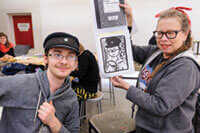
Barry shows a self-portrait made by student Clay Van Mell, a.k.a. Bender (left). She encourages her students to draw self-portraits, use aliases for names — whatever it takes to unleash creativity.
Barry has told me on multiple occasions how education saved her, but it was attending The Evergreen State College in Washington State that cemented her success and dovetailed the beginnings of her nationally syndicated comic strip, Ernie Pook’s Comeek, which ran in more than seventy alternative newspapers for nearly thirty years. She returned to Wisconsin in 2002 with her husband, Kevin Kawula, to live in Rock County, following decades of success as a visual artist, workshop teacher, and author.
The Lynda Barry canon ranges from accounts of growing up in a poor, racially diverse area in a troubled household, to expository writing and imaginative fiction that teach the process of writing and drawing for “people who want to, but don’t know how,” she says. Her work touches on shifting identities between sophomoric naïveté and growing up with an emotionally abusive mother (her parents split early on), between being white and Filipina, between connecting with and doubting her own creativity and ability to make meaning of the world. She’s authored several books, many earning high praise and awards — one was adapted for an off-Broadway musical.
In recent years, as space for newspaper comics dwindled, Barry started spending more time conducting workshops, refocusing on a fundamental question posed by Evergreen State College instructor and artist Marilyn Frasca, whom Barry cites as a catalytic force in her life.
“When I was in school, I started out with this question: What is an image? And by images, I mean the thing that’s contained by everything we call the arts,” Barry tells me. “I got really interested in this idea that they probably have a biological function — we wouldn’t have dragged them through all our evolutionary stages if they didn’t.”
She wonders what makes us long to be able to sing, draw, write, dance, or play music even after we’ve given up on ever being able to do these things well. To get closer to an answer, Barry needed to engage with people for longer periods of time than a two-day workshop allowed.
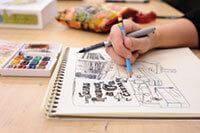
As a student in Barry’s Making Comics class, Art Department lecturer Allison Welch creates a drawing of a vintage Sears Roebuck & Co. catalog.
Enter Tom Loeser, chair of the UW’s Art Department, who, with the support of co-sponsors on campus, nominated Barry to be the Arts Institute Interdisciplinary Artist in Residence for spring 2012. Barry brought her wit and creative flavor to campus, teaching a class, sharing techniques, and even inviting longtime friend and classmate Matt Groening, creator of the popular TV show The Simpsons, to lead an informal, under-wraps talk for students.
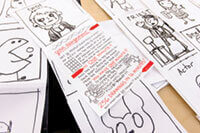
Responding to a group exercise in the class (above), 16 students created 256 character drawings in 16 minutes.
But it wasn’t just arts circles that picked up on her presence. After meeting Barry, WID Director David Krakauer promptly asked her to be a fellow, which evolved into what is thought to be the only joint faculty position in interdisciplinary creativity in the country.
“I’m particularly interested in how formal ideas are fed by informal and exploratory activities,” Krakauer says. “Many very rigorous scientists, including Feynman, Dirac, Poincare, and Darwin all scribbled and doodled furiously, and found inspiration and freedom literally in the margins of their thoughts. Lynda shines a light on these marginal territories and is discovering treasure islands.”
While I tried to pinpoint Barry’s take on disciplines, it became clear to me that she’s disappointed that the arts and sciences are often being placed on opposite ends of the intellectual spectrum, with interactions between the two labeled as “bridges.” For her, the arts and sciences have encompassed each other all along.
“There’s something to this idea of insight,” she tells me. “I want to wrest it away from the hippie-rainbow-love-aura-artsy-fartsy thing — in the same way I want to wrest science away from the strict, indoctrinated thing it’s perceived to be.”

Surrounded by writing utensils, Barry holds close the notebooks that her students fill with words and drawings while enrolled in her courses. Calling them “my babies,” Barry says she takes great pleasure in reading the notebooks multiple times during each semester.
“These Original Digital Devices”
I am sitting in an audience of about fifty researchers, students, and staff in a glass room on the second floor of the Discovery Building, which houses WID. It’s late fall, and Barry is scrolling through a set of images on a projector. I’ve heard her say that researchers’ sketches, whiteboard proofs, and diagrams resemble art drawings, but I have never seen them compared side-by-side.
She points behind her to a large hand-drawn image of a schoolhouse created by an elementary student. The next slide — an eerily similar drawing, with upward sweeping strokes resembling a roof — was not crafted by a child, she says, but rather by scientists explaining a mathematical model on a whiteboard at WID. She shows the crowd numerous comparisons: art versus algorithm, squiggly lines versus scripts of code. The pictures look as if they were created by — inspired by — each other.
“Something about the hand is going on in this building,” she says. Heads in the audience nod. “I’ll see scientists sitting down, much like how artists sit in front of paintings, and occasionally add to them. You can’t take a step upstairs without seeing these whiteboards.”
Decades of visual arts work have allowed Barry to discover this impossible-to-ignore connection between hand and brain. She describes it as that moment you’re spooning food into your mouth and reading the back of a cereal box without even realizing it. Or those “aha” moments in the shower, where ideas flood in uninvited as you’re shampooing or washing off.
The hand-brain connection across disciplines, fields, and age groups has intrigued her for years. The hand knows what it’s doing before the person does, she says, noting that insight happens in the gap between the hand doing its own thing and the mind catching on. It’s the same feeling I had when she challenged me to write articles by hand, even if they need to be typed eventually. There’s a different feeling when you put words on a page and leave them for a while, without the temptation of a backspace button to act on self-doubt.
Barry led the Counterfactual Campus Drawing Board Project for WID, where she asked people of all ages to envision what schools and the university would look like in a century.
“Across the board, people feel that computers and digital stuff — that’s our future. And that little things like desks and handwriting and drawing — all the stuff I care the most about — won’t really be around anymore,” she tells me. “That’s been a little bit hard for me, for someone who thinks thinking, intuition, and all kinds of stuff come from these original digital devices.” She raises her hands in front of her face and wiggles her fingers.
Still, despite future technology, she says, we still overwhelmingly use our hands. This surfaces during a warm-up exercise in Barry’s writing class, when she tells us to relax every fiber of our bodies — almost as if we’re prepping for physical activity — by drawing tightly bound spirals on a page as she recites Rumi’s poem “The Diver’s Clothes Lying Empty” by memory. The hand becomes engaged before the mind.
And it’s not just Barry who’s noticing these connections. She lists study after study suggesting that the biological function of the arts is alive and well: one documented stress reduction after participants sang in a choir; another found that people who doodle while listening performed better with memory recall tests; and yet another revealed a correlation between daily drawing and fewer doctor visits for older people.
These are exactly the types of collaborations that Barry is starting to explore as a faculty member. She’s forming connections with UW researchers — in particular, psychology excites her. And these connections lie at the heart of her Image Lab, a flexible workspace on the first floor of the Discovery Building.
“The metaphor for me is like a restaurant that serves food based on what’s in season, what’s fresh and around,” she says. “If I find that there’s an interesting rehearsal going on for a one-man or two-man show, or there’s some creative project going on on campus that I can invite people to do here, I will. People won’t always know what they’re going to see when they come to the lab — like the chefs that just go to the market in the morning and write the menu based on what they’ve found.”
Art graduate student and collaborator Angela Richardson ’93, MFAx’15 tells me she crosses paths with all types of people in the lab, sometimes talking with them for hours about differences between the brain and mind. These interactions clearly reflect Barry’s proclivity for spontaneous interaction.
“Anybody who wants to make a discovery of some sort has to push to the edge of the known — and then beyond — in order to make the mistake to make the discovery. Lynda Barry understands that deeply,” Richardson says. “The juicy stuff is in the unknown. There are a million other voices telling you, ‘No — don’t go over there,’ but Lynda’s on the other side with the megaphone saying, ‘Hey, you guys! Don’t forget — the good stuff’s over here!’ ”
Richardson has also taken part in Barry’s Stealth Sculpture Project, a rotating exhibit that places pieces of art from the master of fine arts program in the hallways of WID’s workspace. (Okay, admittedly, artist Heather McCalla MA’12’s life-sized wooden car wasn’t exactly stealthy.) Barry’s “Drawing Jam” sessions for kids share similar spunk. She reminds my colleagues and me: “All adults must be accompanied by a child!”
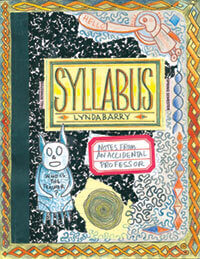
The cover of Barry’s new book, Syllabus, suggests that she’s an accidental teacher, yet she readily acknowledges that teachers changed her life. Lynda Barry.
Dissertation Drawing
I am sitting in Barry’s class, drawing a self-portrait on an index card that will be used to take attendance. We include our names, but in some of her other classes, students go the entire semester without knowing each other’s real names.
Barry encourages aliases in the classroom, giving students fictional names from playing cards and parts of the brain, such as Four of Hearts and Cerebral Cortex. For her Making Comics class in 2013, undergraduate and graduate students took on alternate personas from their favorite cartoon characters. Though Barry plays along as Professor Sluggo and Professor Long-Title, the practice has a purpose: allowing students from different backgrounds and walks of life to feel more at ease.
Ebony Flowers MS’12, PhDx’15, known as Inspector Gadget and Frontal Lobe, has drawn inspiration from Barry’s teaching philosophy while pursuing her doctorate in the School of Education. She hopes to share her research visually through a blend of writing and comics. While talking with me in the Image Lab, Flowers points to a binder outlining a technique she developed and is teaching in a workshop to encourage a new approach to academic writing for graduate students.
“It’s an environment where anyone from any discipline can sit down and write together and share their writing — a similar atmosphere that Lynda has created in her classes,” she says. “There isn’t any criticism, but people can still express themselves and read out their work.”
I examine the document in the binder to find a cartoon fish and chicken that serve as readers’ cheeky guides through an unorthodox writing process.
“Why are you cutting up that journal article?” the fish asks the chicken in one panel. “Because I want to cut up the questions I find in it,” the chicken replies.
This breaking apart, rearranging, brainstorming, and discussing of research unveils patterns in students’ work, much like Barry’s accessible writing approach developed in her Unthinkable Mind class. What’s key, Flowers says, is helping people raise questions and juxtapose images in new ways.
Since the workshops began, Flowers has led writing exercises for dissertators and graduate students in a variety of disciplines, including forestry, agricultural sciences, sociology, educational policy, and history of science. Barry and Flowers are beginning to study the effects of this writing style on people across fields.
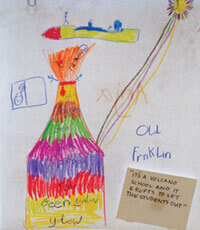
“It’s a volcano school, and it erupts to get the students out,” was the ready answer to explain the drawing above, made when Barry visited a classroom of Madison second-graders and asked them to envision what school might be like one hundred years from now. And the artwork’s other details? “Every student has this machine that can turn into a desk or a bed or a cafeteria or a pumpkin patch. … And there is an automatic sun that has cables that connect to the school for the power.”
Geography graduate student Heather Rosenfeld MSx’15, a.k.a. Optimus Prime, had no drawing experience before enrolling in Barry’s Making Comics class and participating in Flowers’s workshop. She tells me that Barry’s method gives her a way of sharing multiple stories from multiple perspectives, encouraging them to exist in tension. The approach has provided a framework for a side project through which she’s examining the history of gender relations in her department.
“You can analyze this and theorize about that,” Rosenfeld says, “but telling a story in comic form is really different and an entirely different type of challenge. This is definitely something I’ll take with me beyond my time at UW–Madison.”
A Cheerleader for Education
I am sitting at a restaurant table with Barry as she tells me about her time in college — how teachers changed her life and led her to want to do the same. Her time at Evergreen State — where students were encouraged to completely immerse themselves into one class, one topic per term — laid the foundation for her own teaching style.
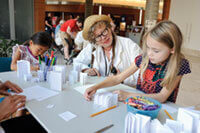
Barry invites young and old to attend the “Drawing Jam” sessions held in her campus Image Lab. At left, she delights as one budding artist begins putting ideas to paper at a Saturday Science at Discovery outreach event at her lab.
“If you were going to study something intensely enough, you’ll end up studying all the disciplines,” she says. “It’s the idea that all these things are tied together. That’s the way I teach.”
Dan Chaon considers Barry an unorthodox cheerleader. Chaon, an award-winning author who teaches creative writing at Oberlin College in Ohio, met Barry in the early 2000s. The two have been exchanging regular emails and visits ever since, sharing approaches and musings.
“There’s a shift from the critic, chooser, and giver of grades to being a coach, cheerleader, and observer that opens up a whole possibility of teaching that’s closed for people who are coming to something with a letter grade in mind,” he says. “Lynda’s work isn’t hippy-dippy, but possesses real rigor. These students are producing an entire book’s worth of material in a semester.”
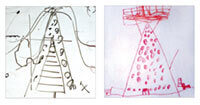
A UW researcher’s sketch on a whiteboard (left) has striking similarities to a youngster’s drawing of a futuristic school, which features a giant steel tent, and an elevator to the playground. Barry shows such examples in her presentations, noting that, no matter the age, people are compelled to use their hands when engaging their brains.
One student in Barry’s The Unthinkable Mind class wrote some forty thousand words in his composition books during the semester. Barry takes her students’ notebooks home for close examination multiple times throughout the duration of each course.
“I get so wrapped up in this work and wrapped up in my students. I have a hard time giving them back their work,” she says. “They won’t love it the way I love it,” she jokes, but behind her glasses, her eyes well up with tears.
Marianne English Spoon MA’11, a writer and communications officer for the Wisconsin Institute for Discovery, sketched and doodled her way through this story.
Published in the Spring 2014 issue


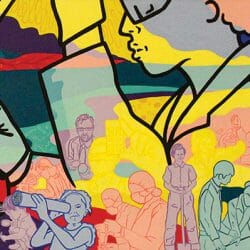

Comments
Rachel Seurer February 28, 2014
Professor Barry-
It’s Pons ( from last semester’s unthinkable mind. ) you transformed my college experience. I’d like to thank you. Also,
The songs you taught us live on.
Love and photo blue pencils,
Rachel
Mary Jo Koranda April 3, 2014
She sounds awesome. I’d like to know if she teaches any classes that UW staff (adult) can take.
Emily Lewis April 6, 2014
Sounds great. I’d like to know if she has any drawing jams for middleschoolers in her campus lab.
Erica April 7, 2014
This is amazing! Will she be hosting any other courses or workshops this semester?
Wisconsin Institute for Discovery April 11, 2014
For those interested in learning more, please check the Image Lab’s webpage, where any upcoming events will be posted: http://wid.wisc.edu/programs/image-lab/events/
Jay Warner April 29, 2014
The problem of developing “problem solving” and “creativity” in people is endemic in our society. We laud what we see as ‘major breakthroughs,’ but ignore the process that allows each of us to accomplish something closer to home. Perhaps Ms. Barry’s work will help change that, and more people will discover their capabilities.
If a technician learns why it is valuable to scoop up a delicate part by a forward twist instead of a backward twist, is this noteworthy? When the defect rate drops from 3% to 0.1%, the company & the customers think so. Was the team that worked out the difference “creative”? I think so. And they went on to make many more improvements, all facilitated by their new-found capabilities.
BTW, It would be nice if the article heading included a dat of posting.